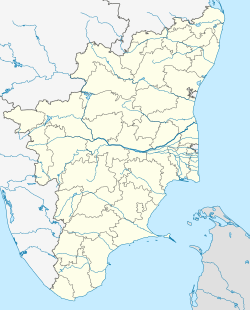Kulasekarapattinam
This article has multiple issues. Please help improve it or discuss these issues on the talk page. (Learn how and when to remove these messages)
|
Kulasekharapatnam
Kulasekarapatnam, Kulasekarapattinam | |
|---|---|
Town | |
| Coordinates: 8°24′0″N 78°3′0″E / 8.40000°N 78.05000°E | |
| Country | |
| State | Tamil Nadu |
| District | Thoothukudi |
| Government | |
| • Body | Kulasekharapatnam Panchayat |
| Area | |
• Total | 12.5 km2 (4.8 sq mi) |
| Population (2001) | |
• Total | 12,010 |
| • Density | 960/km2 (2,500/sq mi) |
| Languages | |
| • Official | Tamil |
| Time zone | UTC+5:30 (IST) |
| PIN | 628206 |
| Telephone code | 4639 |
| Vehicle registration | TN 92 |
| Nearest city | Thoothukudi |
| Sex ratio | 1000:1177 ♂/♀ |
| Literacy | 85.91% |
| Lok Sabha constituency | Thoothukudi Formerly with Tiruchendur |
| Vidhan Sabha constituency | Tiruchendur |
| Civic agency | Kulasekharapatnam Panchayat Board |
| Climate | Humid (Köppen) |
| Website | www |
Kulasekharapatnam is a town in the Thoothukudi district of Tamil Nadu, India. Historically, it was an important port on the Coromandel Coast, alongside Kaveripumpattinam (Poompuhar) and Arikamedu (near Pondicherry).
From at least the 1st century CE, Kulasekharapatnam functioned as a trading hub for the Pandya kingdom. While Kollam served as a major port on the west coast, Kulasekharapatnam connected the Pandyas to Ceylon and the pearl fisheries of the Gulf of Mannar. It was part of a network of ancient coastal settlements that included Kodungallur in Kerala and Barugachha (Broach) in Gujarat.[1] During the Colonial Era, as Tuticorin emerged as a dominant port, the prominence of Kulasekharapatnam declined.[2]
The town's name is derived from the Pandyan ruler Maravarman Kulasekara Pandyan I. Marco Polo's travel accounts from 1250 mention Kulasekharapatnam as a significant trading center.[citation needed]
Kulasekharapatnam is home to the 300-year-old Mutharamman Temple and the Dharmasamvardhini Temple, which lies north of the village. The town is particularly known for its grand Dussehra celebrations.
During British rule, a sugar factory operated profitably in the town, and a customs office was established. The British also introduced the Kulasekharapatnam Light Railway, which, as of 1933, had stations including Kulasekharapatnam Central, Kulasekharapatnam Port, and KPM Sugar Factory.
In recent years, ISRO announced plans to establish a space launch pad at Kulasekharapatnam, positioning it as a key location for India's space missions.[3]
Rowthers & Marakkars settlement
[edit]During the reign of the Pandyas, Kulasekharapatnam was also known as the Rowthers Palayam, a section of Muslims that had military cavalry, followed traditional customs and were horse traders. Kulasekharapatnam was an important trade center even before the arrival of Islam. The current Muslim population of Kulasekharapatnam is known as the Marakkar or Marakkayars who engaged in maritime trade. They had come from Kerala, and it is said that Kunjali Marakkar's family members came from Kerala. Typical of most port towns, Kulasekharapatnam has a lighthouse, located near Manapad. The city has been inhabited by Hindus since the 8th century CE.

Origin of Marakkars
[edit]Marakkar are distinctive Tamil and Malayalam-speaking Muslim people of the states of Tamil Nadu and Kerala in India. The name Marakkar is different from Marakkayar (Marikkar & Maricar are other spellings used in history books). According to numerous historians, Moppila or Moplah is Maha Pillai (great son) and Marakkar means (Marakkalam is a wooden boat) 'boatmen'. Thurston, in his work 'Tribes of South India', states the following - The word Marakkar is usually derived from the Tamil marakalam, meaning 'boat'.[4]
It was also a titular name for maritime traders. Marakkar was a prized title given by the Zamorin of Calicut. Derived from Marakka Rayar, it signifies the captain of a ship ('Rayar' meaning 'king' or, here, 'captain' and 'Marakkalam' meaning 'ship').[4] They are also called marakala rayars, from marakalam ('wooden boat') and rayar ('king') in the Tamil language. The captains of the vessels are called malimars, coming from the Tamil words malumi ('captain') and yar, and crew members are called sherangs.
Traditionally, the Marakkars engaged in mercantile commerce. They are primarily located along the coasts of the southernmost states of Kerala and Tamil Nadu in India.[4]
The Marakala, also known as the Mogela or Mogaveera, community is an influential fishing community in coastal Karnataka. They are traditionally fishermen and their caste profession is fishing in rivers and the sea. The Barkoor Bennekudru Kulamahasthry temple, Uchila Mahalaxmi temple, and Bagvadi Mahishamardini temples are major Mogaveera kuladevata (relating ancestral tutelary deities) temples in coastal Karnataka.
References
[edit]- ^ K. A. Nilakanta Sastri, History of South India, 2nd ed., Oxford University Press, 1958
- ^ "Picnic on the beach". The Hindu. Chennai, India. 15 October 2005. Archived from the original on 29 October 2005.
- ^ "New launch pad in Tamil Nadu to help Isro". Times of India. Retrieved 28 June 2020.
- ^ a b c Maddy. "Search Results Web results The Marakkar's and their origins".


